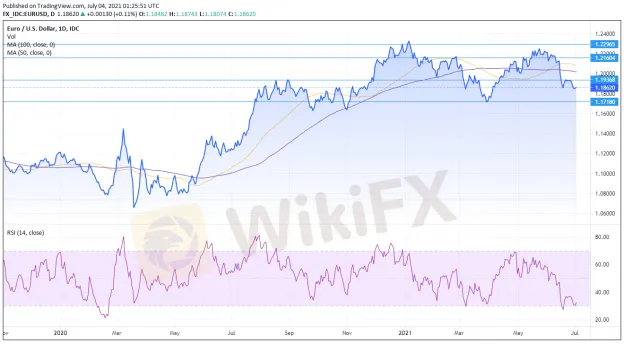简体中文
繁體中文
English
Pусский
日本語
ภาษาไทย
Tiếng Việt
Bahasa Indonesia
Español
हिन्दी
Filippiiniläinen
Français
Deutsch
Português
Türkçe
한국어
العربية
EUR-USD Forecast – Weekly: 5th – 9th July
Özet:The crucial publication looks to have had one specific aim in markets – activating a bearish dollar retracement. The United States increased jobs than projected, 850k. Though, a modest wage advance at 3.6% and the absence of significant bullish retracement are sufficient to induce a bullish advance.

EUR-USD daily chart for the month of July shows bulls is in charge.
The crucial publication looks to have had one specific aim in markets – activating a bearish dollar retracement. The United States increased jobs than projected, 850k. Though, a modest wage advance at 3.6% and the absence of significant bullish retracement are sufficient to induce a bullish advance.
Ahead of a long weekend, traders had many positions close. Nevertheless, EUR-USD stays bearish still on the weekly chart.

Coming week events in the US
Resonances from Friday's Nonfarm Payrolls data will probably impact markets in the early days of the week while Americans maximize their long weekend. Supplementary analysis could influence stockholders to alter their positions. Coming Tuesday, the ISM Services PMI figures for June take over the spotlight, ready to ease from the high level of 64 issued in May.
While the employment section in ISM's statement is to some extent musty second to the NFP, the Prices Paid data is pertinent to the Fed's valuation of inflation prospects.
On Wednesday, the central bank stays in focus, with the issuance of its June meeting minutes. That event manifests a variation point for the dollar, as the Federal Reserve surprised traders with a bullish drift. The plot gestured two interest rate hikes in 2023, and Chair J. Powell proceeded by stating that the argument about narrowing bond-buying is taking off.
EUR-USD Technical Overview
EUR-USD is moving closer towards oversold settings as indicated by the Relative Strength Index of the daily chart. If the RSI plunges beneath 30, the pair could retrace upward. Other pointers as momentum and the 50-day, 100-day, and 200-day Simple Moving Averages all indicate a bearish trend in the long run.
At the early July low of 1.1835 is a support area, shadowed by 1.1760, a pad back in late March. Afterward, the round 1.17 level – EUR-USD launch point in 1999 – is the next line to pay attention to.
At 1.1910 is a resistance area, a former support line from late June. It is ushered by 1.1970, the post-Fed bearish recovery zenith. A persevering lid seats at 1.20, which is not only a mental obstacle but also a support line from May and where the 200-day SMA intersects the price.

EUR-USD Sentimental Overview
The Fed's statement may help as a reminder of the bank's hawkish shift, which could counter a dovish move from the ECB. The spread of the Delta variant across Europe could impact the euro. Above all, there is room for more bears.

Feragatname:
Bu makaledeki görüşler yalnızca yazarın kişisel görüşlerini temsil eder ve bu platform için yatırım tavsiyesi teşkil etmez. Bu platform, makale bilgilerinin doğruluğunu, eksiksizliğini ve güncelliğini garanti etmez ve makale bilgilerinin kullanılması veya bunlara güvenilmesinden kaynaklanan herhangi bir kayıptan sorumlu değildir.
WikiFX Broker
Son Haberler
Deprem bölgesine 500 milyon dolar yeni finansman
Enflasyon ne zaman, saat kaçta açıklanacak? 2025 Mart enflasyon açıklaması
İlk çeyreğin kazananı altın
Borsa günü düşüşle kapattı
Bankalararası Kart Merkezi kart harcama verilerini açıkladı
Benzine zam bekleniyor
TUSAŞ ile Brezilyalı havacılık devinden ortak üretim hamlesi
Borsa günün ilk yarısında yükseldi
Euro Bölgesi'nde üretici fiyatları yükseldi
Borsa haftaya düşüşle başladı
Kur Hesaplayıcı


